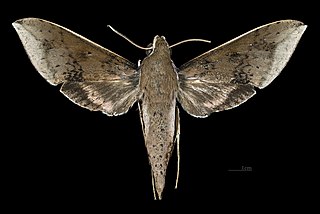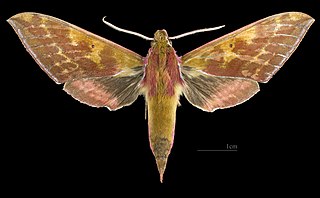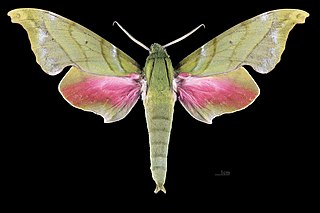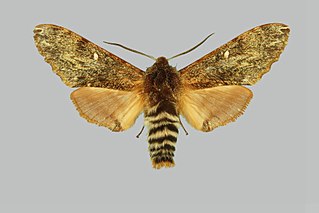
Cechenena helops is a moth of the family Sphingidae first described by Francis Walker in 1856. It is found in Malaysia, Indonesia, the Philippines, Nepal, north-eastern India, Thailand, south-western China and Vietnam.

Anambulyx is a monotypic moth genus in the family Sphingidae erected by Walter Rothschild and Karl Jordan in 1903. Its only species, Anambulyx elwesi, or Elwes' pink-and-green hawkmoth, was first described by Herbert Druce in 1882.

Ambulyx ochracea, the ochreous gliding hawkmoth, is a moth of the family Sphingidae. The species was first described by Arthur Gardiner Butler in 1885.

Amplypterus panopus, the mango hawkmoth, is a moth of the family Sphingidae. The species was first described by Pieter Cramer in 1779. It is found in Sri Lanka, southern and northern India, Nepal, Myanmar, southern China, Thailand, Vietnam, Laos, Indonesia and the Philippines.

Angonyx testacea, the northern dark-green hawkmoth, is a moth of the family Sphingidae.

Cechenena aegrota, the mottled green hawkmoth, is a species of moth in the family Sphingidae. It was described by Arthur Gardiner Butler in 1875. It is known from Nepal, north-eastern India, Bangladesh, Thailand, Laos, southern China and Vietnam.

Rhagastis velata, the veiled mottled hawkmoth, is a moth of the family Sphingidae. It is known from Nepal, north-eastern India, Thailand, central and southern China and Taiwan.

Rhagastis lunata, the lunulate mottled hawkmoth, is a moth of the family Sphingidae. It is known from Nepal, north-eastern India, Thailand, south-western China and Vietnam.

Rhagastis gloriosa, the crimson mottled hawkmoth, is a moth of the family Sphingidae.

Rhagastis confusa, the indistinct mottled hawkmoth, is a moth of the family Sphingidae.

Rhagastis castor is a moth of the family Sphingidae first described by Francis Walker in 1856.

Rhagastis albomarginatus is a moth of the family Sphingidae.

Rhagastis acuta is a moth of the family Sphingidae. It is known from south-east Asia, including India, Thailand and Indonesia.

Neogurelca himachala, the crisp-banded hawkmoth, is a moth of the family Sphingidae. It is known from Nepal, north-eastern India, south-western, central and eastern China, northern Thailand, Taiwan, North Korea, South Korea and Japan.

Cechetra minor, the lesser green hawkmoth, is a moth of the family Sphingidae.

Smerinthulus perversa, the lichenous hawkmoth, is a species of moth of the family Sphingidae. It is known from Taiwan, Nepal, north-eastern India, northern Myanmar, south-western and southern China and Thailand.

Rhodoprasina callantha, the small olive hawkmoth, is a species of moth of the family Sphingidae. It is found from north-eastern India across south-western China and northern Thailand to northern Vietnam.

Pentateucha curiosa, the hirsute hawkmoth, is a moth of the family Sphingidae. The species was first described by Charles Swinhoe in 1908. It is known from Nepal, north-eastern India, Yunnan in south-western China, northern Thailand and northern Vietnam.

Ambulyx substrigilis, the dark-based gliding hawkmoth, is a species of moth of the family Sphingidae. It was described by John O. Westwood in 1847.



















